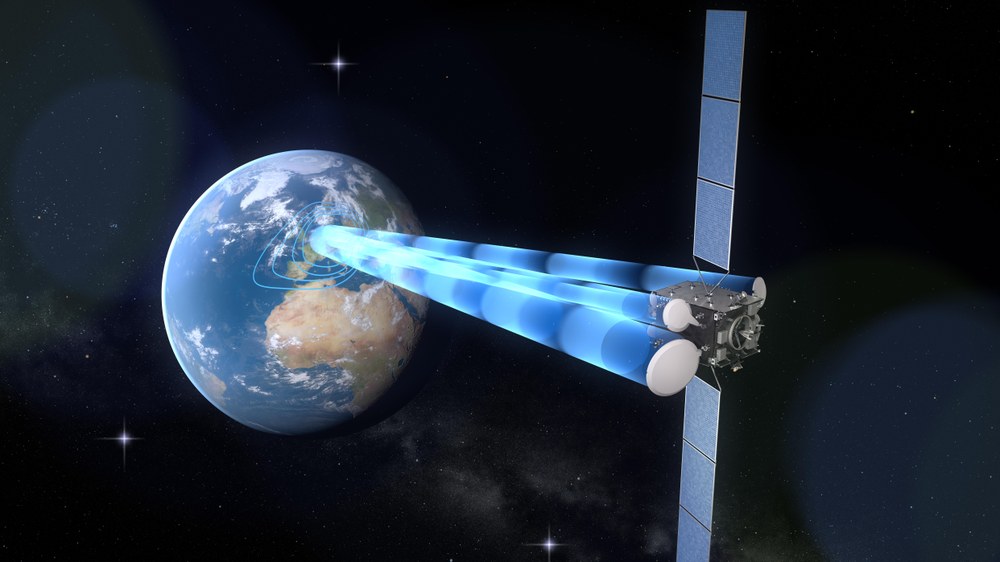OHB and Arianespace reach agreement: Heinrich Hertz to be launched aboard Ariane 5


- On 14 December 2017 at the DLR Space Administration in Bonn, Marco Fuchs, Chairman of OHB System AG, and Stéphane Israël, CEO of Arianespace, signed the contract for the launch of the German communications satellite Heinrich Hertz aboard a European Ariane 5 rocket.
- The launch is scheduled to take place sometime between mid-2021 and the end of 2022.
- Focus: space, digitalisation, Big Data
It is the end of 2021: the German communications satellite and technology demonstrator 'Heinrich Hertz' has been mounted on an Ariane 5 rocket in the final assembly hall, Bâtiment d'Assemblage Final (BAF), at the European Spaceport in French Guiana and is being rolled towards the launch pad, freshly fuelled. A day later, the European launcher lifts off and launches the 3.5-ton satellite into its geostationary transfer orbit as planned. To enable this future scenario to become reality, the foundations were laid with the signing of the launch contract between OHB System AG and Arianespace at the German Aerospace Center (Deutsches Zentrum für Luft- und Raumfahrt; DLR) Space Administration on 14 December 2017. "Heinrich Hertz once again highlights Germany's expertise in the construction of communications satellites. By deciding to use Ariane 5, we have chosen one of our trusted partners. We expect to have excellent collaboration in this German mission," emphasised Gerd Gruppe, Member of the DLR Executive Board responsible for the Space Administration.
Large launch window ensures the success of the mission
"For this Ariane 5 flight, we have also managed to negotiate the largest possible launch window. The launch is scheduled to take place sometime between mid-2021 and the end of 2022. Thanks to this large launch window, nothing stands in the way of the success of this important mission for German satellite communications," explained Gruppe. In these times of digitalisation and Big Data, ever-larger data volumes must be transmitted quickly and reliably. This is made possible by new technologies, such as those being tested in space on Heinrich Hertz. With this mission, Germany is internationally demonstrating its key competences in the payload and platform technologies of geostationary satellites and securing its system capabilities in these areas. These new technologies will be tested under the extreme conditions of space with the enormous temperature fluctuations, microgravity and vacuum environment. Around 20 more experiments on communications, antenna and satellite technology will also be performed. These will be autonomously conducted onboard the satellite, their data transmitted to Earth and evaluated by the participating research institutes and industrial companies, while Heinrich Hertz circles the Earth at an altitude of around 36,000 kilometres in a geostationary orbit.
Inter-ministerial collaboration
Germany is also breaking new ground with the implementation of the ‘Heinrich Hertz’ project: the mission is being jointly undertaken by the German Federal Ministry for Economic Affairs and Energy (BMWi) and the Federal Ministry of Defence (BMVg). The overall project is being managed by the DLR Space Administration, which has been commissioned by both Ministries. 'Heinrich Hertz' is being built, tested and launched by OHB System AG in Bremen, which was also responsible for developing and designing the satellite. The innovative technologies and associated communications experiments originate from over 40 German SMEs and research institutes. The DLR Space Administration is responsible for planning and implementing the project. The Heinrich Hertz satellite mission is financed by the DLR Space Administration with funds from the German Federal Ministry for Economic Affairs and Energy (BMWi) and implemented in collaboration with the German Federal Ministry of Defence (BMVg).
Heinrich Rudolf Hertz
The communications satellite was named after the German physicist Heinrich Rudolf Hertz. Born on 22 February 1857 in Hamburg, he primarily dedicated his research to the analysis of electromagnetic waves. In 1886, he succeeded in transmitting free space electromagnetic waves from a transmitter to a receiver for the first time, thereby laying the foundations for modern communications and media technology. As a result of his groundbreaking research, the Hertz unit of frequency – defined as one cycle per second – was named after him.
